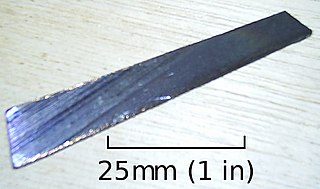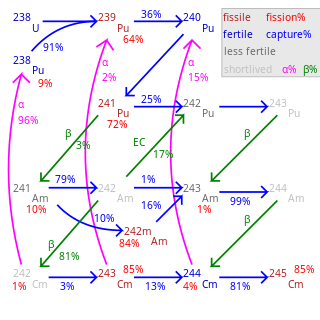Related Research Articles

Nuclear fission is a reaction in which the nucleus of an atom splits into two or more smaller nuclei. The fission process often produces gamma photons, and releases a very large amount of energy even by the energetic standards of radioactive decay.

In nuclear physics, a nuclear chain reaction occurs when one single nuclear reaction causes an average of one or more subsequent nuclear reactions, thus leading to the possibility of a self-propagating series or "positive feedback loop" of these reactions. The specific nuclear reaction may be the fission of heavy isotopes. A nuclear chain reaction releases several million times more energy per reaction than any chemical reaction.
In nuclear engineering, fissile material is material that can undergo nuclear fission when struck by a neutron of low energy. A self-sustaining thermal chain reaction can only be achieved with fissile material. The predominant neutron energy in a system may be typified by either slow neutrons or fast neutrons. Fissile material can be used to fuel thermal-neutron reactors, fast-neutron reactors and nuclear explosives.

Uranium-238 is the most common isotope of uranium found in nature, with a relative abundance of 99%. Unlike uranium-235, it is non-fissile, which means it cannot sustain a chain reaction in a thermal-neutron reactor. However, it is fissionable by fast neutrons, and is fertile, meaning it can be transmuted to fissile plutonium-239. 238U cannot support a chain reaction because inelastic scattering reduces neutron energy below the range where fast fission of one or more next-generation nuclei is probable. Doppler broadening of 238U's neutron absorption resonances, increasing absorption as fuel temperature increases, is also an essential negative feedback mechanism for reactor control.
Uranium-233 is a fissile isotope of uranium that is bred from thorium-232 as part of the thorium fuel cycle. Uranium-233 was investigated for use in nuclear weapons and as a reactor fuel. It has been used successfully in experimental nuclear reactors and has been proposed for much wider use as a nuclear fuel. It has a half-life of 160,000 years.

Plutonium-239 is an isotope of plutonium. Plutonium-239 is the primary fissile isotope used for the production of nuclear weapons, although uranium-235 is also used for that purpose. Plutonium-239 is also one of the three main isotopes demonstrated usable as fuel in thermal spectrum nuclear reactors, along with uranium-235 and uranium-233. Plutonium-239 has a half-life of 24,110 years.
Promethium (61Pm) is an artificial element, except in trace quantities as a product of spontaneous fission of 238U and 235U and alpha decay of 151Eu, and thus a standard atomic weight cannot be given. Like all artificial elements, it has no stable isotopes. It was first synthesized in 1945.
Caesium (55Cs) has 41 known isotopes, the atomic masses of these isotopes range from 112 to 152. Only one isotope, 133Cs, is stable. The longest-lived radioisotopes are 135Cs with a half-life of 1.33 million years, 137
Cs
with a half-life of 30.1671 years and 134Cs with a half-life of 2.0652 years. All other isotopes have half-lives less than 2 weeks, most under an hour.
Tin (50Sn) is the element with the greatest number of stable isotopes. Moreover, tin is not only the element with the greatest number of observationally stable isotopes, but also the element with the greatest number of theoretically stable isotopes. This is probably related to the fact that 50 is a "magic number" of protons. In addition, twenty-nine unstable tin isotopes are known, including tin-100 (100Sn) and tin-132 (132Sn), which are both "doubly magic". The longest-lived tin radioisotope is tin-126 (126Sn), with a half-life of 230,000 years. The other 28 radioisotopes have half-lives of less than a year.
Naturally occurring palladium (46Pd) is composed of six stable isotopes, 102Pd, 104Pd, 105Pd, 106Pd, 108Pd, and 110Pd, although 102Pd and 110Pd are theoretically unstable. The most stable radioisotopes are 107Pd with a half-life of 6.5 million years, 103Pd with a half-life of 17 days, and 100Pd with a half-life of 3.63 days. Twenty-three other radioisotopes have been characterized with atomic weights ranging from 90.949 u (91Pd) to 128.96 u (129Pd). Most of these have half-lives that are less than a half an hour except 101Pd, 109Pd, and 112Pd.
Neptunium (93Np) is usually considered an artificial element, although trace quantities are found in nature, so a standard atomic weight cannot be given. Like all trace or artificial elements, it has no stable isotopes. The first isotope to be synthesized and identified was 239Np in 1940, produced by bombarding 238
U
with neutrons to produce 239
U
, which then underwent beta decay to 239
Np
.
Plutonium (94Pu) is an artificial element, except for trace quantities resulting from neutron capture by uranium, and thus a standard atomic weight cannot be given. Like all artificial elements, it has no stable isotopes. It was synthesized long before being found in nature, the first isotope synthesized being 238Pu in 1940. Twenty plutonium radioisotopes have been characterized. The most stable are plutonium-244 with a half-life of 80.8 million years, plutonium-242 with a half-life of 373,300 years, and plutonium-239 with a half-life of 24,110 years. All of the remaining radioactive isotopes have half-lives that are less than 7,000 years. This element also has eight meta states; all have half-lives of less than one second.

A minor actinide is an actinide, other than uranium or plutonium, found in spent nuclear fuel. The minor actinides include neptunium, americium, curium, berkelium, californium, einsteinium, and fermium. The most important isotopes of these elements in spent nuclear fuel are neptunium-237, americium-241, americium-243, curium-242 through -248, and californium-249 through -252.

Spent nuclear fuel, occasionally called used nuclear fuel, is nuclear fuel that has been irradiated in a nuclear reactor. It is no longer useful in sustaining a nuclear reaction in an ordinary thermal reactor and, depending on its point along the nuclear fuel cycle, it will have different isotopic constituents than when it started.

Weapons-grade nuclear material is any fissionable nuclear material that is pure enough to make a nuclear weapon and has properties that make it particularly suitable for nuclear weapons use. Plutonium and uranium in grades normally used in nuclear weapons are the most common examples.
Plutonium-241 is an isotope of plutonium formed when plutonium-240 captures a neutron. Like some other plutonium isotopes, 241Pu is fissile, with a neutron absorption cross section about one-third greater than that of 239Pu, and a similar probability of fissioning on neutron absorption, around 73%. In the non-fission case, neutron capture produces plutonium-242. In general, isotopes with an odd number of neutrons are both more likely to absorb a neutron, and more likely to undergo fission on neutron absorption, than isotopes with an even number of neutrons.
Uranium-236 (236U) is an isotope of uranium that is neither fissile with thermal neutrons, nor very good fertile material, but is generally considered a nuisance and long-lived radioactive waste. It is found in spent nuclear fuel and in the reprocessed uranium made from spent nuclear fuel.
Plutonium-242 is one of the isotopes of plutonium, the second longest-lived, with a half-life of 375,000 years. The half-life of 242Pu is about 15 times that of 239Pu; so it is one-fifteenth as radioactive, and not one of the larger contributors to nuclear waste radioactivity. 242Pu's gamma ray emissions are also weaker than those of the other isotopes.
Reactor-grade plutonium (RGPu) is the isotopic grade of plutonium that is found in spent nuclear fuel after the uranium-235 primary fuel that a nuclear power reactor uses has burnt up. The uranium-238 from which most of the plutonium isotopes derive by neutron capture is found along with the U-235 in the low enriched uranium fuel of civilian reactors.
Long-lived fission products (LLFPs) are radioactive materials with a long half-life produced by nuclear fission of uranium and plutonium. Because of their persistent radiotoxicity, it is necessary to isolate them from humans and the biosphere and to confine them in nuclear waste repositories for geological periods of time.
References
- ↑ Audi, Georges; Bersillon, Olivier; Blachot, Jean; Wapstra, Aaldert Hendrik (December 2003). "The Nubase evaluation of nuclear and decay properties". Nuclear Physics A. 729 (1): 3–128. Bibcode:2003NuPhA.729....3A. CiteSeerX 10.1.1.692.8504 . doi:10.1016/j.nuclphysa.2003.11.001.
- 1 2 Audi, Georges; Wapstra, Aaldert Hendrik; Thibault, Catherine (December 2003). "The Ame2003 atomic mass evaluation". Nuclear Physics A. 729 (1): 337–676. Bibcode:2003NuPhA.729..337A. doi:10.1016/j.nuclphysa.2003.11.003.
- ↑ Farwell, G. W. (1990). "Emilio Segre, Enrico Fermi, Pu-240, and the atomic bomb". Symposium to Commemorate the 50th Anniversary of the Discovery of Transuranium Elements.
- 1 2 Şahin, Sümer (1981). "Remarks On The Plutonium-240 Induced Pre-Ignition Problem In A Nuclear Device". Nuclear Technology. 54 (1): 431–432. doi:10.13182/NT81-A32795.
The energy yield of a nuclear explosive decreases by one and two orders of magnitude if the 240 Pu content increases from 5 (nearly weapons-grade plutonium) to 15 and 25%, respectively
- 1 2 Bodansky, David (2007). "Nuclear Bombs, Nuclear Energy, and Terrorism". Nuclear Energy: Principles, Practices, and Prospects. Springer Science & Business Media. ISBN 978-0-387-26931-3.
- ↑ Mughabghab, S. F. (2006). Atlas of neutron resonances : resonance parameters and thermal cross sections Z=1-100. Amsterdam: Elsevier. ISBN 978-0-08-046106-9.
- ↑ "Actinide data: Thermal neutron cross sections, resonance integrals, and Westcott factors". Nuclear Data for Safeguards. International Atomic Energy Agency . Retrieved 2016-09-11.
- 1 2 3 4 5 6 Mark, J. Carson; Hippel, Frank von; Lyman, Edward (2009-10-30). "Explosive Properties of Reactor-Grade Plutonium" (PDF). Science & Global Security. 17 (2–3): 170–185. Bibcode:2009S&GS...17..170M. doi:10.1080/08929880903368690. ISSN 0892-9882. S2CID 219716695.
- ↑ Chamberlain, O.; Farwell, G. W.; Segrè, E. (1954). "Pu-240 and Its Spontaneous Fission". Physical Review. 94 (1): 156. Bibcode:1954PhRv...94..156C. doi:10.1103/PhysRev.94.156.
- ↑ Hoddeson, Lillian (1993). "The Discovery of Spontaneous Fission in Plutonium during World War II". Historical Studies in the Physical and Biological Sciences. 23 (2): 279–300. doi:10.2307/27757700. JSTOR 27757700.
- ↑ Şahin, Sümer; Ligou, Jacques (1980). "The Effect of the Spontaneous Fission of Plutonium-240 on the Energy Release in a Nuclear Explosive". Nuclear Technology. 50 (1): 88. doi:10.13182/NT80-A17072.
- ↑ Şahi̇n, Sümer (1978). "The effect of Pu-240 on neutron lifetime in nuclear explosives". Annals of Nuclear Energy. 5 (2): 55–58. doi:10.1016/0306-4549(78)90104-4.